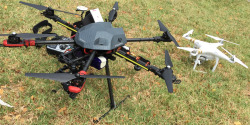
Hawaii Drone Operators Seek, Secure FAA Approval
Drone Services Hawaii has received its coveted Section 333 Exception from the FAA, allowing it to operate commercially. Meanwhile, the Hawaii Drone Academy is hosting a specialized workshop to help other would-be commercial UAV pilots navigate through the same regulatory process.
Drone hovers outside Hawaii Kai woman’s bedroom, but no crime was committed
“There were these green and red LED’s that were coming from the whirring thing and I quickly realized it was a drone outside my bedroom,” she says the drone hovered above the privacy curtain for a few seconds. When she walked toward it, it flew off.
[video]
NDPTC holds Unmanned Aircraft in Disaster Management Class in San Diego
The National Disaster Preparedness Training Center (NDPTC) is developing a course on unmanned aircraft systems (UAS) in disaster management and held its second pilot course in San Diego, CA., on July 13th. UAS, also known as unmanned aerial vehicles or drones, are an emerging technology on the verge of revolutionizing disaster management.
The new course guides government agencies and others in emergency management through the steps to building a successful UAS program, including identifying when UAS would enhance a disaster mission; knowing which UAS vehicles and sensors are best for various situations; understanding the current FAA UAS regulations and related laws; understanding the importance of engaging the local community; ensuring that privacy issues, civil rights, and civil liberties are thoroughly addressed; and learning how to apply for FAA authorization.
This one-day, 8-hour course was held at the emergency operations center of San Diego Gas and Electric (SDGE), which is the first utility company in the U.S. to receive authorization from the FAA to use UAS. The course participants included people from fire departments, emergency management offices, universities, police departments, and others throughout California who were eager to learn how UAS might help their emergency operations. Class participants had many questions that lead to great discussions on how to move forward with designing a UAS program, how to successfully work with the FAA, how to best engage the local community and what pitfalls to avoid, how to incorporate UAS into their existing operations, and how to learn from some of the current positive and negative UAS stories in the news.
Small, unmanned aircraft can be essential tools for finding lost or trapped people using infrared sensors; for post-disaster damage assessment imagery of infrastructure, transportation, and buildings; for delivering critical items such as medicine to stranded people; for providing a temporary communications network when the primary system is damaged by a disaster; for ongoing infrastructure analysis as part of disaster mitigation; and for providing early storm warning public audio announcements via an onboard speaker system, among many other uses.
NDPTC plans to follow up the first UAS course with two other related courses to further help government agencies appropriately develop UAS program that enhance the mission of emergency management. The second course will help integrate UAS into the policies and procedures of disaster management agencies and will help create a framework for bringing UAS operations, mission planning, management, safety, and information flow into existing policies and procedures in disaster management and propose new policies and procedures to fully integrate UAS. The third course will equip people involved in disaster management with the basic tools of UAS imagery analysis, since imagery from UAS is useful in disaster management only if individuals know how to interpret the data and imagery and take actionable steps for decision-making.
Photo From left to right: Ted Ralston, subject matter expert for UAS course; Teena Deering, UAS course instructor and SDGE UAS pilot; and Jennifer Davidson, NDPTC program manager for UAS course, at SDGE’s emergency operations center for the NDPTC UAS course.
Next Step for Drones: Defending Against Them
As Amazon Inc. and Google Inc. consider drones for tasks ranging from package delivery to providing high-speed Internet, regulators and military planners worry that low-cost drones, which are widely available for purchase, could pose a threat to commercial aviation, vital infrastructure and even troops.
Commercial drone use in Hawaii starting to take off
Recreational operators don’t need an exemption, but one is required if money is exchanged or the drone use is done on behalf of a business.
“Someone did get dinged with a $10,000 fine for commercially operating an unmanned aerial system,” said Andrew Richard Hara, CEO of Ena Media Hawaii. “The FAA has been retroactively searching even YouTube for videos that are being propagated.”
[video]
Joint venture becomes first in Hawaii to receive FAA commercial drone certification
[video]
Drone operator chased, tased by ranger at Hawaii Volcanoes National Park
A drone operator was chased and tased by a ranger at Hawai'i Volcanoes National Park. The confrontation happened after park rangers say the man refused to cooperate when he was caught using a drone to video the Kilauea volcano in an area where massive crowds have been gathering at night to witness the rising lava lake.